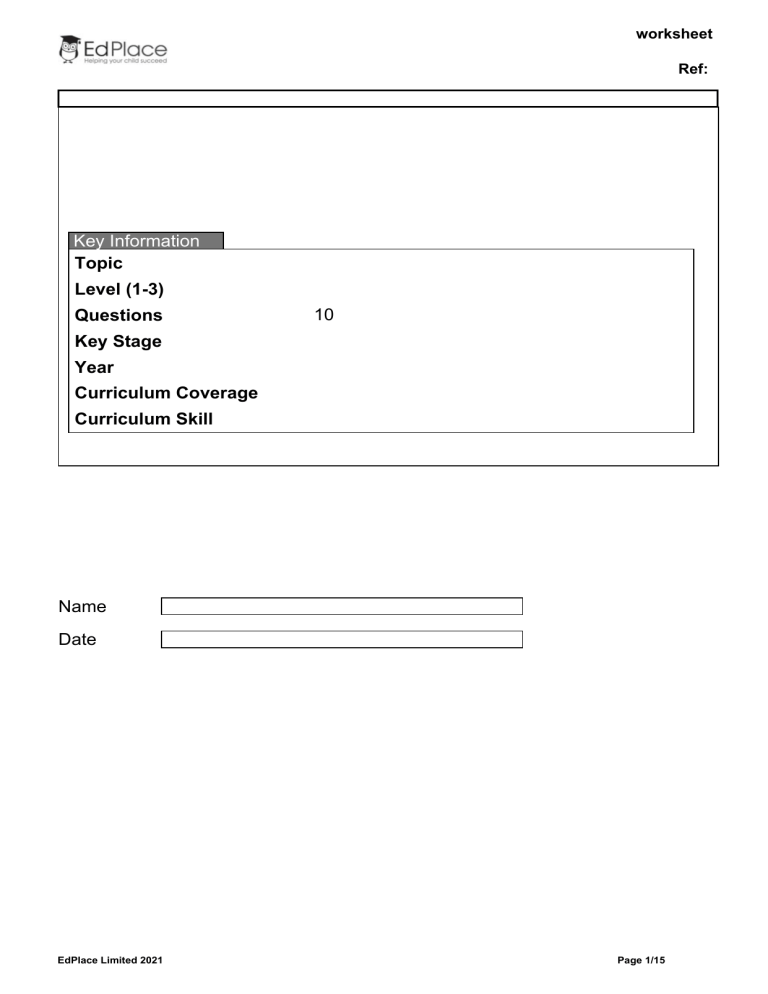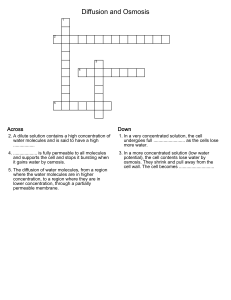Cell Transport Worksheet: Osmosis, Diffusion, Active Transport
advertisement

worksheet Ref: Worksheet Key Information Topic Level (1-3) Questions 10 Key Stage Year Curriculum Coverage Curriculum Skill Name Date EdPlace Limited 2021 Page 1/15 worksheet Ref: Question 1 The table below shows two images, image A and image B, of particles moving through a membrane. Fill in the chart below to show what process is being carried out in each of the two images. A B EdPlace Limited 2021 Page 2/15 worksheet Ref: Osmosis Diffusion Active Transport A B Question 2 Osmosis and active transport are two processes used by cells in plants and animals. Select a similarity between the process of osmosis and active transport. Answer 1 Moves down concentration gradient Answer 2 Energy needed Answer 3 Transports substances into or out of cells Answer 4 Carrier protein needed Question 3 What are some of the differences between osmosis and active transport? EdPlace Limited 2021 Page 3/15 worksheet Ref: Osmosis Active Transport Energy needed Moves down concentration gradient Transports water Transports minerals and nutrients Carrier protein needed Question 4 Plants need important substances for the different processes of life. Plant cells get these substances through diffusion, osmosis and active transport. EdPlace Limited 2021 Page 4/15 worksheet Ref: Match up the sentences to show the differences between the three processes. Column A Active Transport Column B The movement of molecules from an area of high concentration to low concentration The diffusion of water molecules from a dilute solution to a more concentrated solution The movement of molecules against a concentration gradient, and which requires energy Diffusion Osmosis Question 5 What do active transport, diffusion and osmosis have in common? Answer 1 They all require energy Answer 2 They all transport water molecules Answer 3 They all have carrier proteins Answer 4 They all have different concentrations of particles Question 6 Active transport, diffusion and osmosis are all needed for different life processes. Match the processes with the examples given below. Absorbing water from the soil into the roots of a plant Gas exchange in the lungs Absorbing glucose from the intestines during digestion Diffusion Osmosis EdPlace Limited 2021 Page 5/15 worksheet Ref: Active Transport Question 7 The diagram below shows molecules of nitrates in the soil. There are two molecules of nitrates in the soil and four molecules of nitrates in the root hair cell of the plant. Why is it important that the nitrates move by active transport and not diffusion? Answer 1 Diffusion would take longer to transport the nitrates Answer 2 Diffusion would mean the plant would lose nitrates to the soil Answer 3 Diffusion is passive Question 8 EdPlace Limited 2021 Page 6/15 worksheet Ref: Plant and animal cells use active transport, diffusion and osmosis to transport important nutrients into or out of their cells. Compare and contrast these three important processes. Question 9 Glucose is transported into cells for respiration. The picture below shows three molecules of glucose outside a cell and five molecules of glucose inside the cell. Select which arrow fits best in box a and box b below. Answer 1 (a) ? Answer 2 (b) ? EdPlace Limited 2021 Page 7/15 worksheet Ref: Answer 3 (a) ? Answer 4 (b) ? Question 10 The table below shows three images, image A, B and C. Which of these images show particles moving down a concentration gradient? A B EdPlace Limited 2021 Page 8/15 worksheet Ref: C Answer 1 A Answer 2 B Answer 3 C Answer 4 A and C EdPlace Limited 2021 Page 9/15 worksheet Ref: Answer 1 Correct Answers Osmosis Diffusion Active Transport A B Answers Explanation This was a challenging question to start you off with this activity! You need to look very carefully at the images to make sure you don't muddle up diffusion and active transport. The biggest clue to active transport in image A is the presence of a carrier protein, but the direction of the arrows could also have been a clue. The arrows show that the molecules are going from a low concentration (only three of them) to a higher concentration (five of them). Image B has a semipermeable membrane, which suggests this image is showing osmosis. Answer 2 Correct Answers Answer 1 Transports substances into or out of cells Answers Explanation How did you get on with this one? Osmosis and active transport are similar in that they are both used to transport different substances into or out of cells. How they transport these substances is where they differ. Answer 3 Correct Answers EdPlace Limited 2021 Page 10/15 worksheet Ref: Osmosis Active Transport Energy needed Moves down concentration gradient Transports water Transports minerals and nutrients Carrier protein needed Answers Explanation Did you hesitate with the option on concentration gradients? This is the one that will trip most people up! Osmosis is a process where water molecules move down the concentration gradient because they go from a high to a low concentration. In active transport, molecules go the other way, so they go against the concentration gradient. Osmosis and active transport are almost opposite processes in that one is passive (osmosis), and the other needs energy (active transport). Remembering one process will hopefully help you to remember the other! Answer 4 Correct Answers Column A Active Transport Diffusion Osmosis Column B The movement of molecules against a concentration gradient, and which requires energy The movement of molecules from an area of high concentration to low concentration The diffusion of water molecules from a dilute solution to a more concentrated solution Answers Explanation EdPlace Limited 2021 Page 11/15 worksheet Ref: This is a really key thing for you to know, so it's worth spending time learning these definitions if you're not too sure. With osmosis and diffusion, particles move from a higher concentration to a lower concentration. With active transport, it's the opposite - they move from a lower concentration to a higher concentration. Answer 5 Correct Answers Answer 1 They all have different concentrations of particles Answers Explanation Hopefully, you were able to eliminate the first three options since they don't apply to all three processes. Options one and three only apply to active transport, and option two describes osmosis only. The only option that is shared by all three processes is the last one. In order for particles to move, either down a concentration gradient or against it, there need to be different concentrations of particles to start off with. Answer 6 Correct Answers Absorbing water Gas exchange in Absorbing from the soil the lungs glucose from the into the roots of intestines during a plant digestion Diffusion Osmosis Active Transport Answers Explanation EdPlace Limited 2021 Page 12/15 worksheet Ref: There are many examples of active transport, diffusion and osmosis, but the above are some of the most common examples, along with nitrate uptake by plant root hair cells. Make sure you're familiar with these examples for your exams. Answer 7 Correct Answers Answer 1 Diffusion would mean the plant would lose nitrates to the soil Answers Explanation You need to think about what actually happens in diffusion to get this one correct. Remember that active transport is the movement of particles from low to high concentrations. Diffusion is the opposite, so particles will move from a high to a low concentration. If this happened here, the plant would become drained of all its nutrients. Answer 8 Correct Answers Answers Explanation Phew - what a lot of blanks to fill in! If you found it challenging, it might be a good plan to read the Introduction again and have a second go at the questions in this activity. The above question would make great notes for revision, especially for the extended question and answer section in your exams. Answer 9 EdPlace Limited 2021 Page 13/15 worksheet Ref: Correct Answers Answer 1 (a) ? Answer 2 (b) ? Answers Explanation Which way will the molecules move? Is this going from a high to a low concentration or the other way round? The glucose travels against the concentration gradient - from a lower concentration to a higher concentration via the carrier proteins. This means that both arrows will point downwards, towards the five molecules inside the cells. Answer 10 Correct Answers Answer 1 B Answer 2 C Answers Explanation Image A is showing active transport, image B shows osmosis and image C shows diffusion. When particles move down a concentration gradient, it means that they are moving without the use of energy, from a high concentration to a low concentration. This happens in diffusion and osmosis but not in active transport. Well done for completing another challenging activity. How do you feel about this topic now? EdPlace Limited 2021 Page 14/15 worksheet Ref: EdPlace Limited 2021 Powered by TCPDF (www.tcpdf.org) Page 15/15

